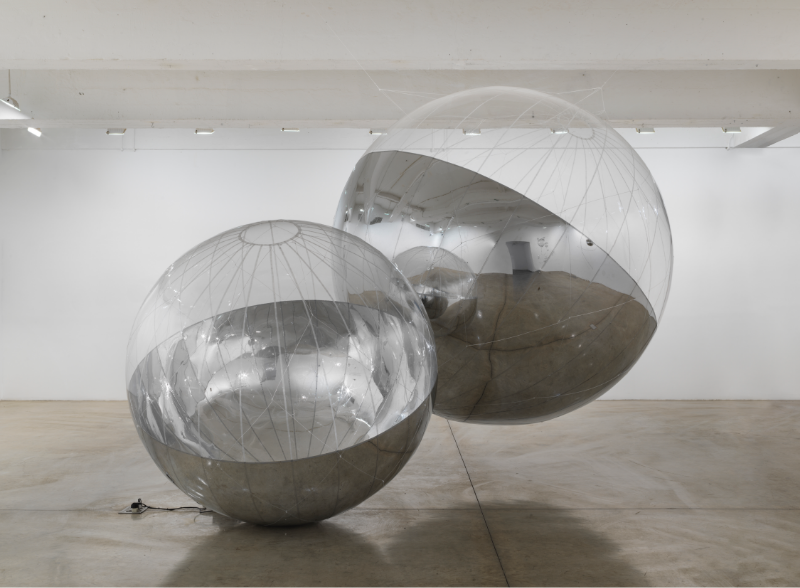Two short films in “Solar Rhythms” at Tanya Bonakdar open Tomás Saraceno‘s proposal for thermodynamic collaboration and remaking human relationships to the Earth.
The first, taken during Saraceno’s ambitious, record-setting flight in White Sands, New Mexico with his D-O AEC Aerocene sculpture/balloon (2015), has the home-movie quality of a Robert Smithson film. Saraceno joins forces of sun and wind as romantically as Smithson did earth and water, to achieve the first pure solar flight.
But Saraceno is an artist-scientist whose innovations extend from aeronautics to arachnology. If it wasn’t clear already from his Hanging Gardens–Cloud Cities (guest artist, Artillery 2011), which have lofted participants on transparent cushions at major museums, then the threads in his films (hot air balloon tethers) and his Calder Upside Down mobiles (2017), ballasted with a hemp rope and stone, draw us closer to the spider’s world, the complicated geometry of its webs (seen in the complicated hand-tied Zonal Harmonic, 2017), but also its employ of nanotechnology to escape gravity.
In another darkened room, three skeins of woven spider silks about eight-feet long undulate to tones played over a loudspeaker in Sounding the Air, an ongoing project. Harvested from spiders in Saraceno‘s safekeeping (with three full-time assistants and ample food) the webs present a philosophical conundrum about human innovation. Future space elevators made of similar proteins could extend our living capacities into the stratosphere and beyond. But social stratification, Saraceno’s work suggests—despite its starry-eyed idealism—weighs us down. His solution? Open-source his discoveries, which include spider web analysis and 3D modeling, home balloon kits (Aerocene Explorer, 2015–) and an app (Aerocene Float Predictor, 2015–) that simultaneously tracks suitable air currents for ballooning and, by extension, global warming. Also: challenge FAA regulations and reclaim the desert, where technocrats, power companies, and power brokers aim to make solar factories and launch pads for our collective survival.
Saraceno’s second film, Diving into the Ocean of Air (2017), documents Aerocene Explorers flying over a contested lithium extraction site. The film reminds us why our devolving social structures in the “enlightened” information age still prevent us taking to the air in this utopian way. Over Salinas Grandes salt lake in Saraceno’s native Argentina, his Aerocene sculptures are looming kites visually reflecting the human misdeeds and terrors that have occurred in the stretches of desert below, specifically in neighboring Chile during Pinochet’s junta. In the mind’s eye, reflecting on the black balloons as if they are film screens, we imagine the thousands of people disappeared with no trace, the desert a black site of the most extreme degree. Lest we forget, hot air balloons were first used in French-Anglo warfare [see: Falling Upward: How We Took to the Air by Richard Holmes]. As Saraceno’s abstract forms quietly steal over the desert like military drones, they gaze down (as do the film’s cameras) instead of floating away from the troubled planet. But then, using no power except the sun, when nighttime comes these balloons of hope, or despair, will fall. The Earth remains our tether, our heads in the sand.












0 Comments